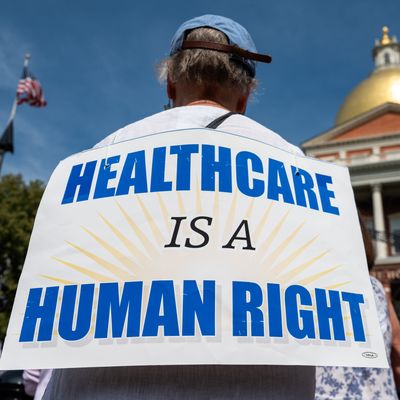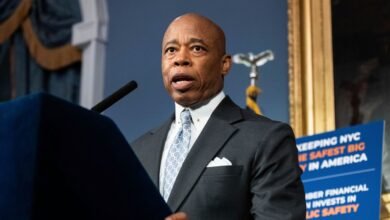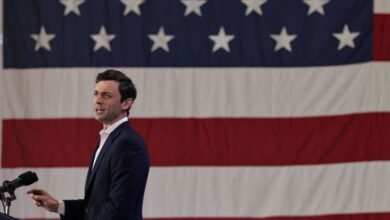What a Diabetes Diagnosis Taught Me About MAHA


Photo: Andrew Burke-Stevenson/Boston Globe/Getty Images
One morning in late September, I drank a cup of coffee without sugar and ate half an English muffin for breakfast. Boring choices, but I like routines; I always drink coffee in the morning, and I always drink it with some milk. If I eat breakfast, I don’t eat much. I didn’t think it mattered — I still wouldn’t, if I had any choice, but two hours later, a medical assistant pricked my fingertip and told me that my blood glucose was 330 milligrams per deciliter. That seems bad, I thought. A few minutes later, I learned my A1C was also much too high, which supported one undesirable conclusion: I have type 2 diabetes, like my mother and millions of other people in the United States, and I’ve likely had it for a while. The doctor sent me home with a sample continuous glucose monitor along with prescriptions for metformin and Mounjaro, a popular GIP and GLP-1 receptor agonist. The following morning, I checked the data from my CGM and saw that my fasting glucose had reached 400 milligrams per deciliter. I did not eat an English muffin.
Still, there is good news: Mounjaro and metformin are effective medications. I know that from my doctor, the scientific literature, and my CGM. A month after getting diagnosed, my blood glucose has declined to safer levels, and the disease frightens me less than it initially did. Pragmatism has taken over. I already have mild neuropathy in my feet, and I’d rather it didn’t get worse. If I want to feel all my toes again, the solution is medication, a better diet, and exercise. There isn’t an easy way to reverse the symptoms of type 2 diabetes, and I knew that the day I found out I had it. I also knew that my illness wasn’t my fault — or I thought I did. People develop type 2 diabetes for a combination of reasons, like a sedentary lifestyle and an unhealthy diet, but genetics matter, too, and I have a family history of the disease. Also, so what? Nobody deserves a life-threatening illness, and a medical diagnosis is not a moral failure. I’ve never thought I should blame my mother for getting sick.
Still, I began to berate myself. I thought about my meals — the small ones, the big ones, the occasional snack — and wondered when I’d crossed the line. Was it the Coke I drank for my headaches? Those English muffins? I told my husband that I felt stupid. I should’ve taken more Pilates classes, eaten fewer carbs, ordered more salads. My husband, an ex-Catholic, told me to be less of a Protestant. Shame has its place in the world, but not here, in this conversation or this illness. He’s right, but in the Make America Healthy Again era, I find it difficult to silence that angry voice in my head. Every time I scroll through Instagram, I see ads and videos that promote dubious supplements and fad diets — and then there is the Robert F. Kennedy Jr. of it all. Diabetes is a fixation for our Health and Human Services secretary, who believes America suffers from a “chronic-disease epidemic” that can be resolved through better nutrition. “Sugar is poison,” he said this year, and it is “giving us a diabetes crisis.” Conditions like diabetes deserve more attention than measles, he claimed amid a deadly outbreak of the infectious disease. Pharma companies want to sell GLP-1s like Mounjaro because “we’re so stupid and so addicted to drugs,” Kennedy told Fox News last year, adding, “If we just gave good food, three meals a day, to every man, woman, and child in our country, we could solve the obesity and diabetes epidemic overnight.”
The MAHA ethos contains an element of truth, which makes it even more insidious. Our choices do influence our physical condition, whether we’re at risk for type 2 diabetes or not, but we are also more complicated than MAHA admits. A woman who lives in a food desert needs more from her government than nutrition education; she can’t simply bootstrap her way out of medical danger. Neither can I despite my relative security. By the time I found out I was diabetic, I was too sick to manage my blood sugar through diet and exercise alone, and I may need medication for the rest of my life. My health depends on my salary and my health insurance, not my choices alone, and that’s the reality most of us live with. Instead, MAHA prefers a commonplace American myth, and so does my inner scold: Fix your mind, make better choices, and health will follow. Self-mastery is free-market logic in another guise, and it won’t make Americans healthy at all.
If the key to health lies in the mind, our “chronic disease” crisis is more spiritual than material. We are making ourselves sick, so we must heal ourselves. When MAHA attempts any structural diagnosis, it complains of big pharma and big agriculture, but individual choices are still the principal focus. Industry is bad because it encourages bad decision-making; it provides shortcuts, like antidepressants or GLP-1s, so we can avoid the hard work of good health. The underlying theme is “mind-power,” as scholar Kate Bowler wrote in Blessed, her 2018 history of the prosperity gospel. Mind-power and “its discourse of control and efficacy” is “centered on the role of thought and speech,” according to Bowler, who traced it back to a Victorian-age religious awakening in American life. “Self-mastery became an art and occupation, as people sought to consolidate the era’s advances with improvements to their own lives,” she wrote. Faith healers promised miraculous cures to believers who paid their tithes and said the right prayers to the right version of God.
In an extreme case, Mary Baker Eddy “discovered” Christian Science and taught her followers that all matter “is infinitely malleable through the power of mind,” as the journalist and ex–Church of Christ, Scientist member Caroline Fraser explained in God’s Perfect Child. Disease was a mental error that should be rectified by good thoughts. Christian Scientists reject most medical interventions and rely, often, on Church practitioners, who say they guide physical healing through the pursuit of spiritual truth. The results can be deadly, as Fraser showed in her book. Children have died because of their parents’ religious convictions. “The history of the United States of America is a history of religious sects that have sanctified the power of self,” Fraser argued, which is hard to dispute.
Now, mind-power as a concept is more powerful than Christian Science or even organized religion, and it is embedded deeply in our national bedrock. Though MAHA is an eclectic perspective, and most who fall under its umbrella accept some medical intervention, its rejection of expertise and reliance on the self are familiar enough. When Kennedy conflates type 2 diabetes with its type 1 counterpart, as he has done in the past, he makes a scientific error that is shaped by his ideology. When he says in the same interview that “juvenile diabetes and prediabetes” can “be reversed completely by changing diet,” he makes a different mistake for the same reasons. Kennedy isn’t asking us to pray, but he is telling us to purify ourselves, and, like Eddy, he takes that moralism and calls it science.
MAHA shifts responsibility for health and well-being onto the individual, and that too is an old trick. Mind-power may emphasize thought, but it still requires some labor from believers, who may depend on objects and ritualized behavior to attract health and wealth or dispel spiritual and mental attacks. Bowler wrote that Creflo Dollar, the prosperity-gospel preacher, once “advised the saints to cure poverty with dollar bills hidden in their shoes.” Kennedy and Martin Makary, the FDA commissioner, recommend wearable health technologies, like my CGM. Unlike a dollar bill inside a shoe, a CGM can have a real purpose, but that also depends on who’s wearing it. Right now, I use a sample Dexcom G7. A sensor in my left arm takes a reading every five minutes and feeds that information into an app on my phone. If my blood sugar gets too low or too high, an alarm sounds and I can take action. Most people don’t need a CGM, but Makary assigns the device a near-talismanic power: Make it widely available and users can ward off a dreadful fate. “Why are we holding these tools to help people empower them with knowledge about their health until after they’re sick?” he said during his Senate confirmation hearing.
Donald Trump’s surgeon-general nominee, Casey Means, founded the Levels app, which connects to a CGM and warns users if they’re experiencing a glucose “spike.” This is not as helpful as it sounds. Blood sugar always rises after a meal and returns to baseline sometime later, and there’s no evidence that spikes lead to health problems in most people, according to a recent story from The Cut. Levels may promise a path to well-being, but that’s marketing, not science. The app merely creates busywork for whoever is using it, and it relies on mind-power. Levels bombards the average person with information they don’t need so they can adjust habits that may not require correction. Once they’re convinced of their own inner failures, an “expert” steps in with a fix. The app’s backers include Mark Hyman, a celebrity in the pseudoscientific field of functional medicine. Hyman’s views on GLP-1 drugs are mixed at best; for blood-sugar control, he once recommended Himalayan Tartary-buckwheat-sprout powder, an unproven supplement.
MAHA sells a seductive idea: Take this powder, wear this device, or use this app and you’ll become the captain of your own body and the master of your own future. The implications are grim — if you get sick anyway, you’ve failed, and you are rightly on your own. “By tying health outcomes to individual choices and digital self-surveillance, MAHA policies risk making healthcare less equitable and overall, less effective,” the writer Scott Gavura observed at Science-Based Medicine. “Unproven technologies” can feel empowering, he added, but in practice they divert “attention away from public health interventions that actually work, like vaccinations, nutrition assistance, and access to primary care.” Mind-power and self-mastery are useful concepts to the White House and the rapacious capitalism it worships. Why should anyone care about type 2 diabetes or what it does to the people who have it? Just eat less pizza.
Here’s a little secret about type 2 diabetes (it’s not really a secret): The disease is expensive. I’ve already spent hundreds of dollars on co-pays, prescriptions, and supplies, and I still don’t know if my insurance plan will cover the Dexcom G7 that I’ve been sampling. If it doesn’t and I want to keep using the device, I’ll likely pay hundreds more out of pocket every month. My insurance does cover a different CGM, the FreeStyle Libre 3, but a month’s supply still costs me $77. A lot of people with diabetes forgo a CGM and track their blood sugar with a blood-glucose meter and finger sticks, but I need both thanks to a genetic quirk. I was born with a hereditary red-blood-cell disorder, which makes my case more complicated to manage; thank you, God, for your intelligent design. At least I have insurance, a decent salary, and a reliable work schedule, so I can keep up with my doctor’s appointments. I’m a union member, which provides a level of security that I would otherwise lack. And I live in a neighborhood where I can walk to the nearest grocery store and choose from a variety of fresh vegetables.
My prognosis is good because I have material advantages that many people lack. According to one analysis from GoodRx, people pay an average of $2,712 per year to self-manage their blood glucose, whether they have insurance or not. That figure includes a blood-glucose monitor, lancets, and test strips but not a CGM. Costs may be higher or lower depending on the specifics of a person’s treatment and their socioeconomic circumstances. For uninsured and underinsured Americans, test strips alone “could add up to thousands of dollars a year,” the New York Times reported in 2019. Out-of-pocket costs are higher for Americans with type 1 diabetes, one study found, but as I’ve learned, type 2 is not exactly affordable, either, and the expense can make it more difficult to manage the condition while preventing future complications. Self-mastery only gets us so far. The choices we make depend in part on the decisions of others, including policy-makers who allow inequality to flourish owing to inaction or malice. Research cited by the CDC says that “adults who experience food insecurity are 2 to 3 times more likely to have type 2 diabetes.” If you’re poor and can’t afford healthy food and a safe place to live, your health tends to suffer. I’ve seen that at home in southwest Virginia, a rural and predominantly white area, but the crisis is widespread and pronounced among members of some racial minority groups. Inequality helps explain why Black Americans develop type 2 diabetes at much higher rates, as do Latinos, Pacific Islanders, and Native Americans. In MAHA logic, people of color are more likely to get type 2 diabetes because something’s wrong with their character, their minds, and it’s DEI to say otherwise.
The MAHA prescription mostly ignores reality because it must. Universal health care would violate its deepest conviction, which is that people who get sick deserve to be punished for it. When Senator Bernie Sanders asked Kennedy if he thought health care is a human right, he demurred. Health care is not a right like free speech is a right, he said, because “if you smoke cigarettes for 20 years and you get cancer, you … you are now taking from the pool,” draining valuable resources. Now that he’s in power, he and the Trump administration have done nothing to make America healthier than usual. Nutrition experts say that MAHA’s favorite solutions, like the removal of high-fructose corn syrup, synthetic dyes, and seed oils from our food, ignore riskier ingredients in ultraprocessed items. Kennedy will soon release new dietary guidelines urging Americans to eat foods high in saturated fat, but as MedPage Today has reported, there’s no real evidence to support the recommendation. Trump has said he wants to lower the cost of GLP-1 agonists, but he also lies, and Mehmet Oz of the Centers for Medicare & Medicaid Services has only uttered vague assurances that Medicare will negotiate better prices for the drugs. On Friday, the Washington Post said the average Obamacare premium will rise by 30 percent next year, based on rates set by Oz’s agency and the probable “expiration of pandemic-era subsidies.”
My inner scold is quieter now, and in its place, there is rage — not just for myself but for my mother, who has struggled sometimes to afford diabetes care, and for people I do not know. A society can become so obsessed with the self that an individual life no longer matters.
Source link





